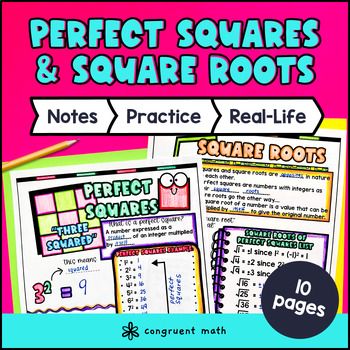Want more ideas and freebies?
Get my free resource library with digital & print activities—plus tips over email.
Join for Free Resources →
$4.25
Ever wondered how to teach perfect squares and square roots in an engaging way to your eighth grade students?
In this lesson plan, students will learn about perfect squares and square roots and their real-life applications. Through artistic, interactive guided notes and practice worksheets including a color by code activity, students will gain a comprehensive understanding of perfect squares and square roots.
The lesson culminates with a real life example that explores how designers use perfect squares and square roots to design bathroom tiles.

$4.25
After this lesson, students will be able to:
Before this lesson, students should be familiar with:
As a hook, ask students why designers need to understand perfect squares and square roots when designing bathroom tiles. Refer to the real-life application on the last page of the guided notes for ideas.
Use the first page of the guided notes to introduce perfect squares. Walk through the key points of identifying perfect squares and the properties of perfect squares. Refer to the FAQs for a walk-through on this, as well as ideas on how to respond to common student questions.
Continue using the guided notes to introduce square roots. Walk through the key points of square roots and how to find the square root of a perfect square. Refer to the FAQs for a walk-through on this, as well as ideas on how to respond to common student questions.
Based on student responses, reteach concepts that students need extra help with. If your class has a wide range of proficiency levels, you can pull out students for reteaching, and have more advanced students begin work on the practice exercises.
Have students work through the problems on the "You Try" page, either collaboratively or independently. Walk around and spot-check student answers on the check for understanding activity.
Fast finishers can dive into the color by code activity included in the resource for extra practice. You can assign it as homework for the remainder of the class.
Bring the class back together, and introduce the concept of applying perfect squares and square roots in real-life scenarios. Explain to the students that understanding perfect squares and square roots can be useful in various situations, such as designing bathroom tiles.
To engage the students, ask them to imagine that they have been hired as interior designers to create a pattern for a set of bathroom tiles. Explain that they need to come up with a design that uses perfect squares and square roots to determine the dimensions of the tiles.
Encourage students to think about how they can use the concept of perfect squares and square roots to ensure that the tiles fit well and create an aesthetically pleasing pattern. Emphasize the importance of accurately calculating the dimensions of the tiles using square roots.
Refer to the FAQ or additional resources for more ideas on how to teach the real-life application of perfect squares and square roots.
If you’re looking for digital practice for perfect squares, square roots, and related concepts, try the Pixel Art activities in Google Sheets. Every answer is automatically checked, and correct answers unlock parts of a mystery picture. It’s incredibly fun, and a powerful tool for differentiation.
Here is an activity to explore:
A fun, no-prep way to practice perfect squares, square roots, and related concepts is with the Doodle Math activities. They’re a fresh take on color by number or color by code. It includes multiple levels of practice, perfect for a review day or sub plan.
Here is an activity to try:
Perfect squares are numbers that can be expressed as the product of an integer multiplied by itself. For example, 4 is a perfect square because it can be written as 2 x 2.
Square roots, on the other hand, are the inverse operation of squaring a number. The square root of a number is a value that, when multiplied by itself, gives the original number. For example, the square root of 16 is 4 because 4 x 4 = 16.
To determine if a number is a perfect square, you can try to find its square root. If the square root is a whole number, then the original number is a perfect square. For example, the square root of 49 is 7, so 49 is a perfect square.
Determining the square root is akin to asking, "What number, when multiplied by itself, gives me the original number?" Exploring various approaches can simplify the process of finding square roots:
For students that need a more visual explanation, I find the Khan Academy video helpful:
The square root of a perfect square is always a whole number. In other words, if a number is a perfect square, its square root is an integer. Likewise, if the square root of a number is an integer, then the original number is a perfect square.
Perfect squares and square roots are not just for math class; they can be pretty handy in real-life situations that are relatable to middle schoolers. Here are some examples:
So, perfect squares and square roots are not only cool math concepts but also tools you can use to solve everyday problems!
Perfect squares and square roots can be used in equations that involve variables raised to the power of 2. For example, the equation x² = 9 can be solved by finding the square root of both sides, which gives x = ±3. The square root of a perfect square can help simplify equations and find possible solutions.
To practice working with perfect squares and square roots, you can use the digital activities like Perfect Squares and Square Roots Google Sheets Pixel Art as well as print worksheets like Perfect Squares and Square Roots Doodle Math for further practice.
Get my free resource library with digital & print activities—plus tips over email.
Join for Free Resources →